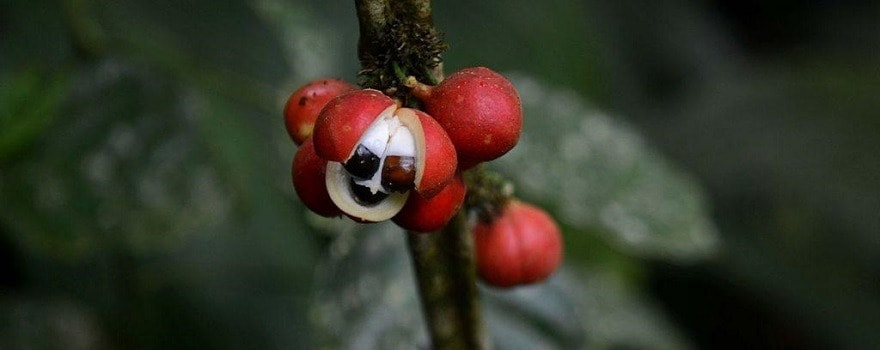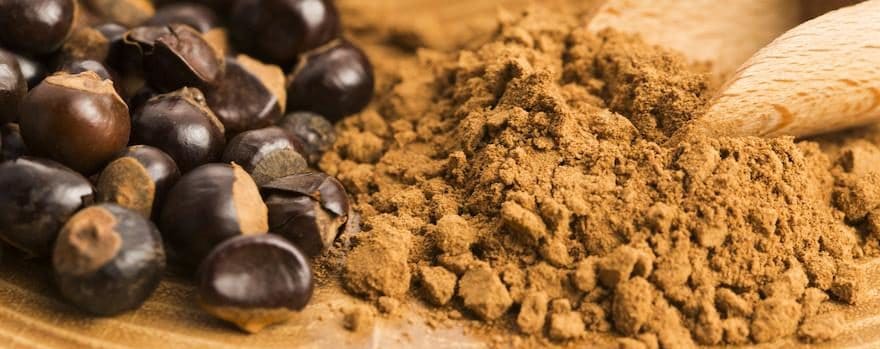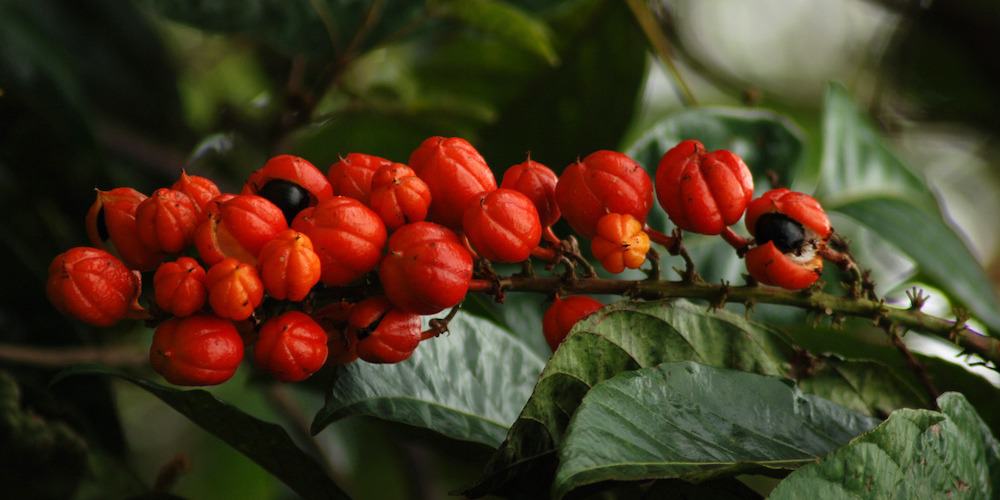Guarana, an excellent natural tonic
Anti-fatigue and stimulant native to the Amazon
Guarana is traditionally consumed by the Indigenous peoples of the Amazon Satéré Mawé as an appetite suppressant and to improve alertness during their runs in the forest. The seed was introduced to Europe as early as the 18th century, where it was consumed for its stimulating and diuretic properties.
Today, guarana is mainly consumed for its anti-fatigue properties. The seed is one of the key ingredients in commercial energy drinks.
Guarana contains between 4 and 6% caffeine, i.e., three to four times more than coffee. Moreover, the caffeine contained in guarana (also called guaranine) has the advantage of being released more gradually than coffee in the body.
This seed is also part of what are called natural nootropics, because its active compounds help improve cognitive functions and boost brain function. Thus, studies show that guarana supplementation improves memory and learning ability, for example. And its tannins allow the caffeine to be released over time.
Another notable effect of guarana: it helps our body burn fat more easily. It is therefore recommended for use in weight-loss diets, or simply to help stay in shape.
The cultivation of organic guarana

Guarana traditionally grows in the tropical forests of the Americas. It mainly grows in Brazil, where it is still very popular both as a traditional remedy among Indigenous peoples and as a beverage.
Also read the Guarana, a health drink?
Guarana comes from a shrub that produces reddish-orange fruits with eye-shaped seeds. That is why guarana is also called eye of the forest. It takes its name from the Guarani people, an indigenous tribe found in the Brazilian Amazon. The Satéré-Mawé people traditionally call it “Warana”, a protected designation of origin that can be found on quality products.
The guarana seeds consumed by Indigenous peoples are sourced from wild harvesting or from an extractive production method (a forest planted with other species of food and medicinal plants).
Faced with the success of guarana as an energizing superfood, manufacturers began to take an interest in its production and to intensify it, even if that meant favoring monoculture and genetically modifying the plant for better yields.
Today, the two production methods coexist, one traditional with seeds of organic guarana, and the other more intensive, intended more for energy drinks. To make the most of guarana’s virtues while protecting the environment and the Amazon rainforest, we will favor organic guarana.
How to consume it?
Traditional consumption of guarana
Guarana is consumed as pure seeds, in capsules or powder, diluted in water or juice. It can be used for occasional fatigue or as part of a treatment course.
Indigenous tribes consume roasted guarana seeds, then ground into powder and diluted in water. This bitter drink is the traditional beverage of the Satéré-Mawé people. They call it çapo.
It is used as a ritual drink to welcome guests, or as a medicinal beverage. They are the true guardians of this plant : « guaraná cannot grow as a shrub without the Sateré Mawé, and the Sateré Mawé cannot live without guaraná ».

Guarana: powder, seeds, or capsules?
Guarana is rarely found in this traditional form in our regions. You can buy organic guarana powder, to dilute in water, juice or yogurt once or twice a day, but its bitter taste may discourage some people.
Organic guarana capsules should be taken as a treatment course. If the powder can be more easily measured, the capsules are the most practical form. Organic guarana seeds can be chewed directly in the mouth ; it is recommended not to exceed ten seeds per day.
Read also | Our tips for choosing the right guarana powder or capsule
Guarana can also be used in organic cosmetics for its antioxidant and anti-aging properties. It is sometimes included as an ingredient in anti-aging creams. Used internally, it is also an excellent ally for skin beauty!
Precautions for use
Guarana should be consumed in the morning to best enjoy its energizing effects. Beware of the risks of insomnia in case of overdose or if guarana is consumed too late in the day !
It is preferable not to exceed 5g of guarana per day, or even less if one also consumes coffee or another source of caffeine.
Why choose organic guarana?
Industrial guarana loses some of its benefits
The great success of guarana in Brazil and beyond has led manufacturers to cultivate the seed intensively. However, it is preferable to consume organic guarana to fully benefit from its properties.
The cultivation of guarana on an industrial scale is carried out with heavy use of fertilizers and pesticides, which causes irreversible damage to the soils and waters of the fragile ecosystem that is the Brazilian Amazon.
Moreover, the roasting of industrial guarana is done in iron ovens, which allows faster drying but disrupts the seed’s chemical composition. It thus loses some of its beneficial properties.

For health and the environment, choose organic, fair-trade guarana
Organic guarana comes from a production method that prohibits chemical fertilizers and pesticides. There is therefore no risk of finding pesticide residues when you consume certified organic guarana.
It is also preferable to choose the fair-trade guarana : this will give you the assurance that it comes from small plantations in the Amazon rainforest, and that the producers earn a decent income.
Traditional guarana growers, especially the Indigenous tribes of the Americas, possess millennia-old expertise in the cultivation and processing of this plant. By consuming organic, fair-trade guarana, you help ensure that this knowledge is respected and preserved.
The guarana native to the Satéré Mawé Indians, for example, is marketed as fair trade, which ensures both the nutritional quality of the product and the preservation of the environment and traditional know-how. Special attention is therefore paid to labels and origin when buying guarana.



